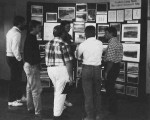The Decomposition workshop organized by Mark Harmon (H.J. Andrews) centered around the intersite fine litter decomposition experiment currently being installed in the field at 21 sites (17 LTER and four others). The study, which was designed at a workshop held in Woods Hole in 1989, will involve annual sampling over a 10-year period, except for tropical sites where faster decomposition will require a three-month interval.
Nine standard litters (six leaf, three “fine” root) are being placed at each site; these species vary in nitrogen and lignin content. The concept of using “wildcard” species to check the results has been incorporated into the design, and identical wooden dowels are being placed in the soil at each site to discern site effects on woody debris decomposition.
The discussion then turned to the development of a proposal to be sent to the National Science Foundation Ecosystems panel. Participants were particularly concerned about receiving credit for their contributions. This issue was resolved in the decision to have three to four investigators submit the proposal with one key participant per site identified as part of the research team.
Funding will be sought to run the experiment, cover the costs of sample processing and chemical analysis, and hold a workshop marking the first five years. Participants agreed in principle that each site would provide support to harvest the samples and provide background data, and that the only costs to be recovered would be for chemical analysis and data management.
A proposal draft was scheduled to be sent out to all participants by mid- November, and a final draft by December. A small workshop involving the modeling aspects of the proposal was held at Wood’s Hole in November.
Another group concern was data sharing and authorship. To meet these concerns, the following guidelines were developed:
- Each site will receive its own site data and has priority on this data for one year after the receipt from the central data bank at Oregon State University, Corvallis.
- Small groups of sites will be free to publish smaller syntheses; i.e., the tropical sites, which will have completed work prior to the others.
- Team synthesis papers using all the data were planned to summarize findings at one, five, and 10 years.
Also considered was the possible addition of six to seven new sites with support from the group. Sites with interest in this area were encouraged to develop their own studies.
Finally, the need to decide what climate indices to use for characterizing sites was discussed. It was clear that mean annual values would not distinguish seasonally distinct climates. A related concern was the degree to which MET stations would be located near each of the four replicate litterbag sites and, if not, how to “correct” for the other locations.

 Enlarge this image
Enlarge this image